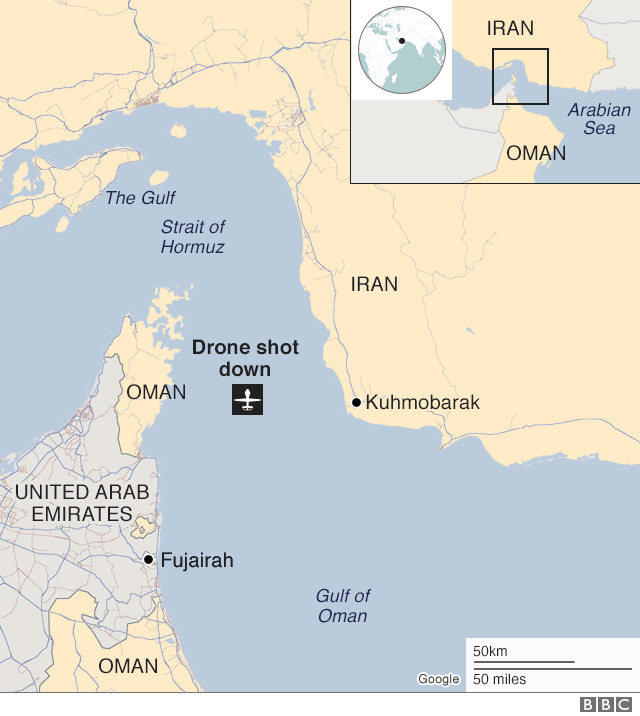President Donald Trump approved retaliatory military strikes against Iran on Thursday before changing his mind, US media reports.

The New York Times, citing senior White House officials, said strikes were planned against a “handful” of targets.
They say the operation was allegedly under way “in its early stages” when Mr Trump stood the US military down.
The strikes were in response for Iran earlier shooting down a US spy drone, the newspaper said.
Iran claims the unmanned US aircraft entered their airspace early on Thursday morning. The US maintains it was shot down in international airspace.
The incident comes at a time of escalating tension between the two countries.
The US has recently blamed Iran for attacks on oil tankers operating in the region and Iran has announced it will soon exceed international agreed limits on its nuclear programme.
What does the New York Times say?
The newspaper first published details of the apparent planned strikes late on Thursday night in Washington. Several other US media outlets then independently reported the same.
The NYT said that as late as 19:00 local time (23:00 GMT) US military and diplomatic officials still expected the strikes on agreed targets, including Iranian radar and missile batteries, to take place.
“Planes were in the air and ships were in position, but no missiles had been fired when word came to stand down” the newspaper reported, citing an unnamed senior administration official.

The strikes were set to take place just before dawn on Friday to minimise risk to the Iranian military or to civilians, the newspaper added.
It remains unclear if the apparent strikes could still go ahead.
The White House and Pentagon have not commented on the reports.
What happened with the drone?
On Thursday morning, Iran’s Islamic Revolutionary Guard Corps (IRGC) announced its air force had shot down a US “spy” drone in the early hours after the unmanned aircraft violated Iranian airspace near Kuhmobarak in the southern province of Hormozgan.
Later the US military’s Central Command confirmed that a US Navy Broad Area Maritime Surveillance (BAMS-D) aircraft was shot down by an Iranian surface-to-air missile system.


However, US military officials maintain the drone was in international airspace over the Strait of Hormuz at the time.
In response, the US Federal Aviation Administration (FAA) issued an emergency order on Thursday evening prohibiting US airlines from operating in an overwater area of Tehran-controlled airspace nearby in response.
It said there were “numerous civil aviation aircraft operating in the area” at the time the US drone was shot down.
What has Mr Trump said?
Mr Trump himself has not yet responded to the reports about the plan for strikes against Iran.
He did, however, make several comments about the drone incident earlier on Thursday.
“Iran made a big mistake,” he said, alleging the US had scientific evidence the drone was in international airspace when it was shot from the sky.
Asked about his response to the incident and whether or not he would go to war with Iran, the president repeatedly replied: “You’ll find out”.
He also suggested its shooting down could have caused by human error.
In a speech on Iranian state TV, IRGC commander-in-chief Maj-Gen Hossein Salami said the drone’s downing was a “clear message” to the US that Iran’s borders were “our red line”.
Foreign minister Javad Zarif later said Iran had retrieved sections of the US military drone “in our territorial waters where it was shot down”.
What other reaction has there been?
Russia’s President Vladimir Putin has warned that war between the US and Iran would be a “catastrophe with unpredictable consequences”.
UN Secretary General Antonio Guterres has urged all parties to exercise maximum restraint.
In the US, Democratic House Speaker Nancy Pelosi said the US had no appetite for war with Iran, while the leading candidate for the Democratic presidential nomination, Joe Biden, called Mr Trump’s Iran strategy a “self-inflicted disaster”.
The top Democrat in the US Senate, Chuck Schumer, said: “The president may not intend to go to war here, but we’re worried that he and the administration may bumble into a war.”
What else has fuelled US-Iran tensions?
On Monday, the US defence department said it was deploying 1,000 extra troops to the region in response to “hostile behaviour” by Iranian forces.
Earlier that day, Iran also announced its stockpile of low-enriched uranium would next week exceed limits it agreed with world powers under a landmark nuclear deal in 2015.
Iran stepped up its production in response to tightening economic sanctions from the US, which unilaterally withdrew from the deal last year.
The US has also accused Iran of attacking two oil tankers with mines last Thursday just outside the Strait of Hormuz, in the Gulf of Oman.
It was the second time in a month tankers had been attacked close in the region, through which a fifth of the world’s oil passes each day.
Iran denies blame for the attacks. BBC News





